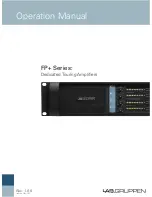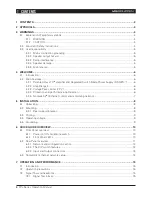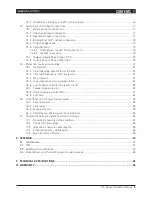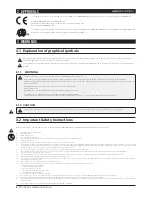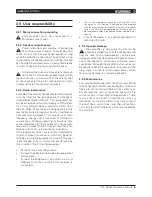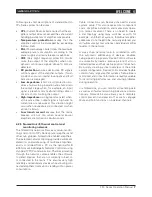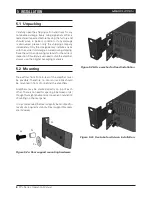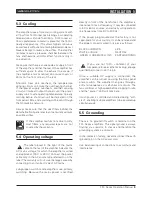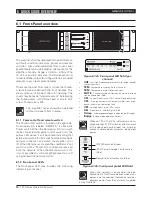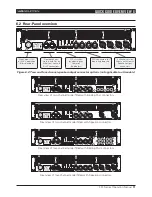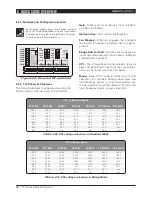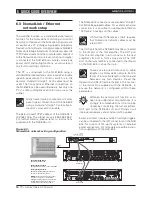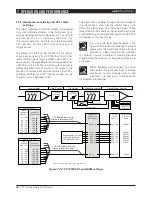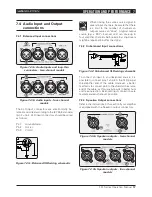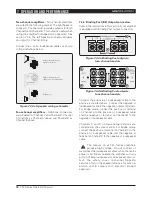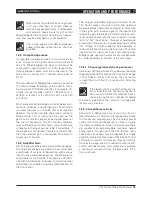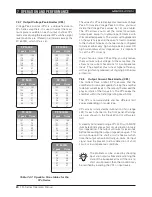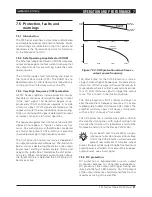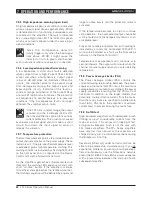
FP+ Series Operation Manual
7
Following are short descriptions of standard built-in
FP+ Series protection features:
CPL
▸
, (Current Peak Limiter) ensures that the am-
plifier’s output does not exceed the safe current
handling parameters of amplifier components.
Temperature protection
▸
ensures that the
amplifier will not be damaged by exceeding
thermal limits.
PAL
▸
, (Power Average Limiter) limits the maximum
average power consumption according to the
power supply and mains-breaker capabilities.
Vhf
▸
, (Very High Frequency) protection circuits
mute the output of the amplifier when non-
dynamic continuous signals above 10 kHz are
detected.
dC protection
▸
ensures destructive DC signals
will not appear at the amplifier outputs. If such
conditions occur an internal fuse opens and fault
indication is displayed.
Low-impedance
▸
(short circuit) protection pro-
vides a fault warning indication and shuts down
the output stage when, for example, an input
signal is present and a malfunctioning cable or
driver is short circuiting the output.
high-impedance
▸
warning reports an alert when,
at the same time, output signal is high and no
current draw is measured. This situation might
occur when no speakers are connected, or when
a driver is blown.
Low inrush current
▸
ensures that the mains
breaker will not trip when several power
amplifiers are turned on simultaneously.
4.2.5 NomadLink / Ethernet control and
monitoring network
The NomadLink network allows easy setup, monito-
ring, and control of FP+ Series power amplifiers and
other Lab.gruppen NomadLink-enabled amplifiers.
The patented network topology provides automatic
detection and addressing of multiple amplifiers,
and is controlled from a PC via the optional NLB
60E NomadLink Bridge & Network Controller using
standard TCP/IP communication. Phantom powering
through the network cables enables the software
to detect devices that are not currently turned on
or connected to the mains. This ensures very high
reliability and redundancy levels while allowing con-
nected amplifiers to remain on standby with no power
consumption.
Cable connections can be daisy-chained for easier
system setup. This also reduces total component
costs, simplifies installation, and makes daily opera-
tion more convenient. There is no need to create
a star topology using many switches as with, for
example, an Ethernet system. Individual amplifier
addresses do not need to be manually entered; you
will automatically know where an individual amplifier
resides in the network.
A daisy chain network loop, in combination with
the automatic addressing of devices, enables
Lab.gruppen’s proprietary DeviceControl software
to automatically create a precise picture of all con-
nected devices and their relative position in the chain.
By quickly creating a clear overview of the entire
system configuration, DeviceControl provides flexible
control of very large amplifier systems. Set-up time is
minimized, and critical information is readily available
for monitoring performance and solving problems
during operation.
Via NomadLink, you can monitor all metering data
as well as all faults and warning indications simulta-
neously. NomadLink also allows you to remotely
control power on and power off, as well as engage
Mute and Solo functions on individual channels.
WELCOME 4

